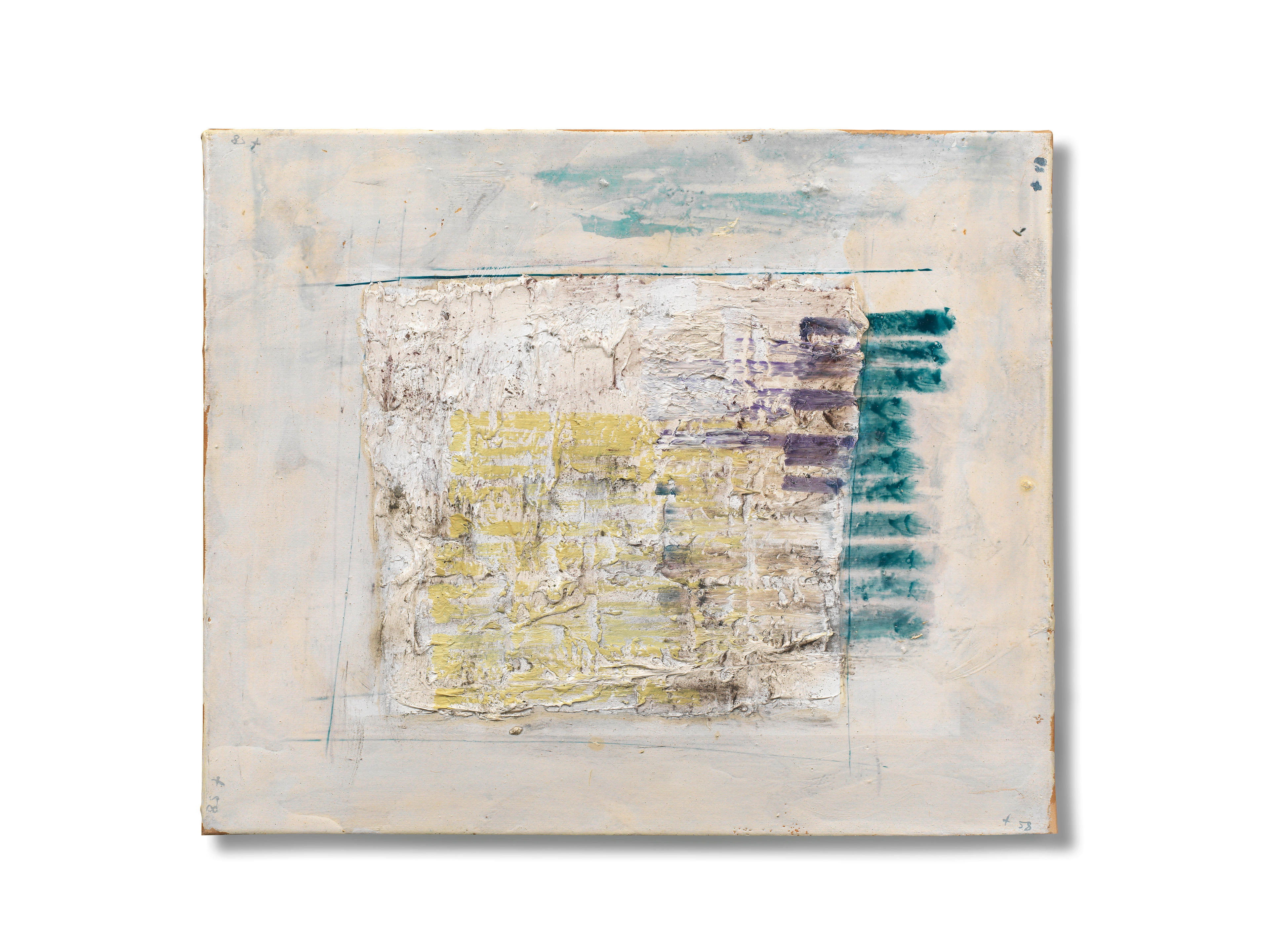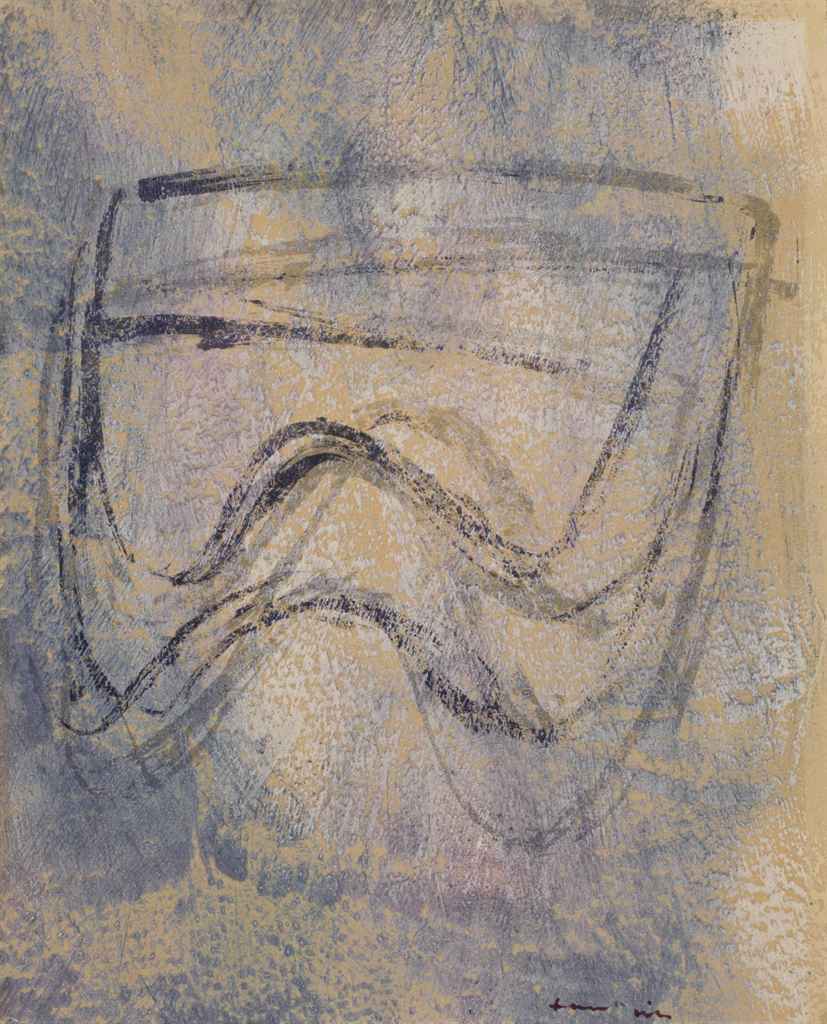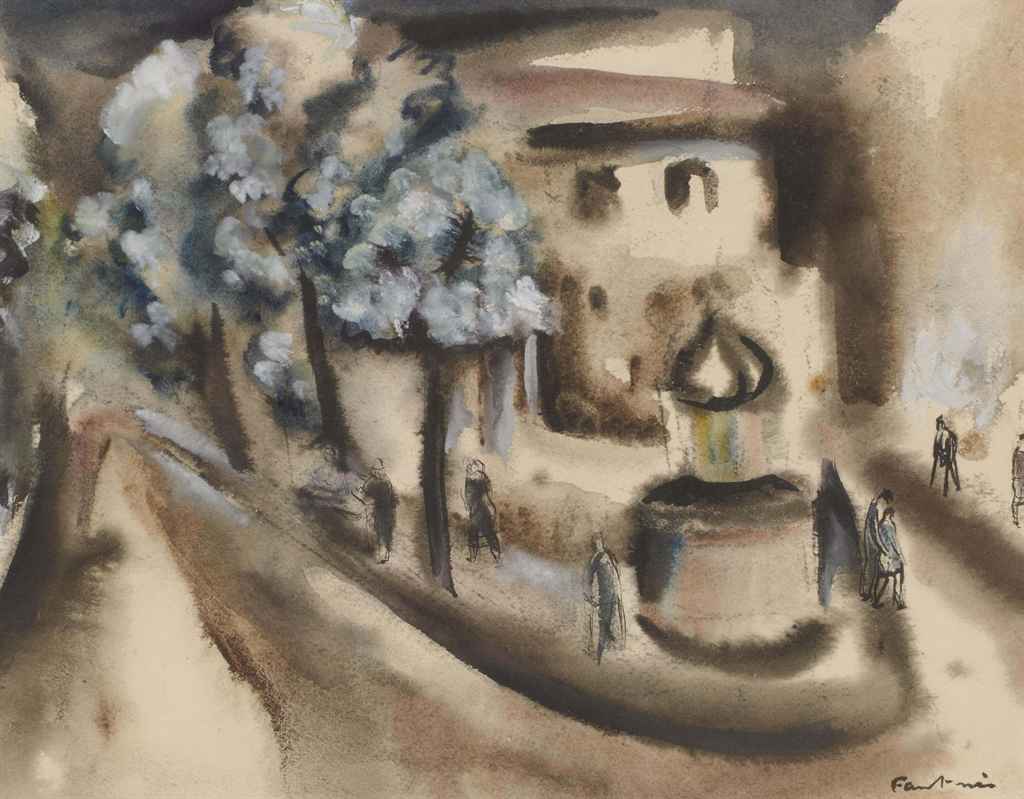JEAN FAUTRIER (1898-1964)Oregon
1957
signed and dated 57 on the lower right; titled on the stretcher
mixed media on paper laid on canvas
64.5 by 80.7 cm.
25 3/8 by 31 3/4 cm.
FootnotesProvenance
Galerie Rive Droite, Paris
Prospero Guarini Collection, Milan
Private Collection, Europe
Gift from the above to the present owner
Literature
Palma Bucarelli, Jean Fautrier pittura e materia, Milan 1960, p. 357, no. 374, illustrated in black and white
Oregon from 1957 and Surfaces de couleurs, tableau à quatre cotés from 1958 are two truly outstanding examples of Jean Fautrier's famous haute pâte (high paste) technique. Characterised by an almost alchemistic use of materials, both works masterfully incorporate the thick layers of impasto and vibrant accents of colour so typical for the artist's practice, and one cannot fail to notice the influence of Art Brut and his fellow collaborators Jean Dubuffet and Wols. Succeeding Fautrier's famous "Hostages", a series that is widely regarded as one of the most significant examples of post-war European painting, the present works have been executed in a mature phase of the artist's life, shortly before he was internationally acclaimed at the Venice Biennale in 1960, where he shared the Grand Prize for Painting with Hans Hartung
Both Surfaces de couleurs, tableau à quatre cotés and Oregon have a distinctly non-objective quality, with the titles offering little information as to the subject matter. With a desire to express reality through the materiality of paint, Fautrier strove to achieve a liberated figuration in his later life. Edouard Roditi explained that '[Fautrier] now paints qualities or substances rather than objects, achieving a new kind of sensual abstraction which is far more appropriate, in the art of painting, than the puritanical denial of sensual delights that one can detect in the merely geometrical abstractions of Mondrian' (Edouard Roditi, 'Foreword,' in Jean Fautrier Paintings, Gouaches, Drawings ed. Hanover Gallery, London 1959, p.8). Signed in all four corners, Surfaces de couleurs, tableau à quatre cotés has more than one possible orientation which adds to the element of abstraction and the feeling of the artist relinquishing control over the viewing experience. This particular motif began to appear in selected works from 1957 onwards and has been linked to the artists interest in the writings of French theorist, Georges Bataille and his notion of 'formlessness' that seeks to undermine rational modes of understanding.
A painter as well as an illustrator and sculptor, Jean Fautrier is widely known for his contribution to the Tachisme movement in the 1940s and 1950s. Emerging after World War II as a response to the trauma and devastation caused by the war, Tachisme - also known as Art Informel - can be seen as the European equivalent to Abstract Expressionism. The movement emphasised spontaneous and intuitive creation, with a strong focus on gesture and texture. Fautrier's technically adept oeuvre is characterised by a deep concern for the human condition and deals with themes of abstract lyricism and melancholia founded in his experiences during the war. His characteristic Haute Pâte technique was achieved by a rejection of canvas painting; instead, he worked on paper which would then be laid on canvas using a knife or spatula. The artist said that: "The canvas is now merely a support for the paper. The thick paper is covered with sometimes thick layers of a plaster – the picture is painted on this moist paper – this plaster makes the paint adhere to the paper perfectly – it has the virtue of fixing the colours in powder, crushed pastels, gouache, ink, and also oil paint – it is above all thanks to these coats of plaster that the mixture can be produced so well and the quality of the matter is achieved" (the artist in: Karen Butler, Fautrier's First Critics: André Malrauz, Jean Paulhan and Francis Ponge, London 2002, pp. 43-44).
Born in Paris in 1898, Jean Fautrier studied at the Royal Academy and at the Slade School in London. During his time abroad, he was influenced by the works he saw in the National Gallery and the Tate, especially the work of J.Y.M. Turner whom he admired and whose influence especially in regard to colour can be felt in the present works. During the 1930s, Fautrier's work began to shift from the rigid academic style commonly taught; he abandoned traditional painting techniques and began to experiment with new materials and processes, becoming increasingly abstract and expressionistic. He soon began to incorporate non-traditional materials such as sand, gravel and plaster into his paintings, creating textured surfaces that were both tactile and visually striking. It is to this end that Fautrier considered himself a sculptor rather than a painter, carving and moulding his teasingly tangible surfaces to achieve spectral luminosity and raw presence.
Throughout his life, Jean Fautrier composed intricate, radiant harmonies whose impastos and textures induce a certain quiet anxiety and intense grandeur. His work has been exhibited extensively throughout Europe and the United States and can be found in the collections of the Museum of Modern Art, New York, the Art Institute of Chicago, the National Gallery of Art in Washington D.C., the Museo Nacional Centro de Arte Reina Sofía, Madrid, the Musée d'Orsay, Paris and the Tate Collection in London. He died during the summer of 1964, just after his first retrospective at the Musée d'Art Moderne de la Ville de Paris and just a few years after the two present exquisite works were executed.Additional informationAuction informationBuyers' ObligationsALL BIDDERS MUST AGREE THAT THEY HAVE READ AND UNDERSTOOD BONHAMS' CONDITIONS OF SALE AND AGREE TO BE BOUND BY THEM, AND AGREE TO PAY THE BUYER'S PREMIUM AND ANY OTHER CHARGES MENTIONED IN THE NOTICE TO BIDDERS. THIS AFFECTS THE BIDDERS LEGAL RIGHTS.If you have any complaints or questions about the Conditions of Sale, please contact your nearest customer services team.Buyers' Premium and ChargesFor all Sales categories, buyer's premium excluding Cars, Motorbikes, Wine, Whisky and Coin & Medal sales, will be as follows: Buyer's Premium Rates
28% on the first £40,000 of the hammer price;
27% of the hammer price of amounts in excess of £40,000 up to and including £800,000;
21% of the hammer price of amounts in excess of £800,000 up to and including £4,500,000;
and 14.5% of the hammer price of any amounts in excess of £4,500,000.VAT at the current rate of 20% will be added to the Buyer's Premium and charges excluding Artists Resale Right.Payment NoticesFor payment information please refer to the sale catalog.Shipping NoticesFor information and estimates on domestic and international shipping as well as export licences please contact Bonhams Shipping Department.Lot Symbols*Import low rateVAT on imported items at a preferential rate of 5% on Hammer Price and the prevailing rate on Buyer's Premium.ARArtists Resale RightGoods subject to Artists Resale Right Additional Premium.Related DepartmentsImpressionist and Modern ArtPrints & MultiplesPost-War and Contemporary ArtAuction ViewingsLondon, New Bond Street24 June 2023, 11:00 - 17:00 BST25 June 2023, 11:00 - 17:00 BST26 June 2023, 09:00 - 18:00 BST27 June 2023, 09:00 - 16:00 BST28 June 2023, 09:00 - 18:00 BST29 June 2023, 09:00 - 12:00 BSTConditions of SaleView Conditions of Sale
JEAN FAUTRIER (1898-1964)Oregon
1957
signed and dated 57 on the lower right; titled on the stretcher
mixed media on paper laid on canvas
64.5 by 80.7 cm.
25 3/8 by 31 3/4 cm.
FootnotesProvenance
Galerie Rive Droite, Paris
Prospero Guarini Collection, Milan
Private Collection, Europe
Gift from the above to the present owner
Literature
Palma Bucarelli, Jean Fautrier pittura e materia, Milan 1960, p. 357, no. 374, illustrated in black and white
Oregon from 1957 and Surfaces de couleurs, tableau à quatre cotés from 1958 are two truly outstanding examples of Jean Fautrier's famous haute pâte (high paste) technique. Characterised by an almost alchemistic use of materials, both works masterfully incorporate the thick layers of impasto and vibrant accents of colour so typical for the artist's practice, and one cannot fail to notice the influence of Art Brut and his fellow collaborators Jean Dubuffet and Wols. Succeeding Fautrier's famous "Hostages", a series that is widely regarded as one of the most significant examples of post-war European painting, the present works have been executed in a mature phase of the artist's life, shortly before he was internationally acclaimed at the Venice Biennale in 1960, where he shared the Grand Prize for Painting with Hans Hartung
Both Surfaces de couleurs, tableau à quatre cotés and Oregon have a distinctly non-objective quality, with the titles offering little information as to the subject matter. With a desire to express reality through the materiality of paint, Fautrier strove to achieve a liberated figuration in his later life. Edouard Roditi explained that '[Fautrier] now paints qualities or substances rather than objects, achieving a new kind of sensual abstraction which is far more appropriate, in the art of painting, than the puritanical denial of sensual delights that one can detect in the merely geometrical abstractions of Mondrian' (Edouard Roditi, 'Foreword,' in Jean Fautrier Paintings, Gouaches, Drawings ed. Hanover Gallery, London 1959, p.8). Signed in all four corners, Surfaces de couleurs, tableau à quatre cotés has more than one possible orientation which adds to the element of abstraction and the feeling of the artist relinquishing control over the viewing experience. This particular motif began to appear in selected works from 1957 onwards and has been linked to the artists interest in the writings of French theorist, Georges Bataille and his notion of 'formlessness' that seeks to undermine rational modes of understanding.
A painter as well as an illustrator and sculptor, Jean Fautrier is widely known for his contribution to the Tachisme movement in the 1940s and 1950s. Emerging after World War II as a response to the trauma and devastation caused by the war, Tachisme - also known as Art Informel - can be seen as the European equivalent to Abstract Expressionism. The movement emphasised spontaneous and intuitive creation, with a strong focus on gesture and texture. Fautrier's technically adept oeuvre is characterised by a deep concern for the human condition and deals with themes of abstract lyricism and melancholia founded in his experiences during the war. His characteristic Haute Pâte technique was achieved by a rejection of canvas painting; instead, he worked on paper which would then be laid on canvas using a knife or spatula. The artist said that: "The canvas is now merely a support for the paper. The thick paper is covered with sometimes thick layers of a plaster – the picture is painted on this moist paper – this plaster makes the paint adhere to the paper perfectly – it has the virtue of fixing the colours in powder, crushed pastels, gouache, ink, and also oil paint – it is above all thanks to these coats of plaster that the mixture can be produced so well and the quality of the matter is achieved" (the artist in: Karen Butler, Fautrier's First Critics: André Malrauz, Jean Paulhan and Francis Ponge, London 2002, pp. 43-44).
Born in Paris in 1898, Jean Fautrier studied at the Royal Academy and at the Slade School in London. During his time abroad, he was influenced by the works he saw in the National Gallery and the Tate, especially the work of J.Y.M. Turner whom he admired and whose influence especially in regard to colour can be felt in the present works. During the 1930s, Fautrier's work began to shift from the rigid academic style commonly taught; he abandoned traditional painting techniques and began to experiment with new materials and processes, becoming increasingly abstract and expressionistic. He soon began to incorporate non-traditional materials such as sand, gravel and plaster into his paintings, creating textured surfaces that were both tactile and visually striking. It is to this end that Fautrier considered himself a sculptor rather than a painter, carving and moulding his teasingly tangible surfaces to achieve spectral luminosity and raw presence.
Throughout his life, Jean Fautrier composed intricate, radiant harmonies whose impastos and textures induce a certain quiet anxiety and intense grandeur. His work has been exhibited extensively throughout Europe and the United States and can be found in the collections of the Museum of Modern Art, New York, the Art Institute of Chicago, the National Gallery of Art in Washington D.C., the Museo Nacional Centro de Arte Reina Sofía, Madrid, the Musée d'Orsay, Paris and the Tate Collection in London. He died during the summer of 1964, just after his first retrospective at the Musée d'Art Moderne de la Ville de Paris and just a few years after the two present exquisite works were executed.Additional informationAuction informationBuyers' ObligationsALL BIDDERS MUST AGREE THAT THEY HAVE READ AND UNDERSTOOD BONHAMS' CONDITIONS OF SALE AND AGREE TO BE BOUND BY THEM, AND AGREE TO PAY THE BUYER'S PREMIUM AND ANY OTHER CHARGES MENTIONED IN THE NOTICE TO BIDDERS. THIS AFFECTS THE BIDDERS LEGAL RIGHTS.If you have any complaints or questions about the Conditions of Sale, please contact your nearest customer services team.Buyers' Premium and ChargesFor all Sales categories, buyer's premium excluding Cars, Motorbikes, Wine, Whisky and Coin & Medal sales, will be as follows: Buyer's Premium Rates
28% on the first £40,000 of the hammer price;
27% of the hammer price of amounts in excess of £40,000 up to and including £800,000;
21% of the hammer price of amounts in excess of £800,000 up to and including £4,500,000;
and 14.5% of the hammer price of any amounts in excess of £4,500,000.VAT at the current rate of 20% will be added to the Buyer's Premium and charges excluding Artists Resale Right.Payment NoticesFor payment information please refer to the sale catalog.Shipping NoticesFor information and estimates on domestic and international shipping as well as export licences please contact Bonhams Shipping Department.Lot Symbols*Import low rateVAT on imported items at a preferential rate of 5% on Hammer Price and the prevailing rate on Buyer's Premium.ARArtists Resale RightGoods subject to Artists Resale Right Additional Premium.Related DepartmentsImpressionist and Modern ArtPrints & MultiplesPost-War and Contemporary ArtAuction ViewingsLondon, New Bond Street24 June 2023, 11:00 - 17:00 BST25 June 2023, 11:00 - 17:00 BST26 June 2023, 09:00 - 18:00 BST27 June 2023, 09:00 - 16:00 BST28 June 2023, 09:00 - 18:00 BST29 June 2023, 09:00 - 12:00 BSTConditions of SaleView Conditions of Sale








.jpg)
.jpg)





Testen Sie LotSearch und seine Premium-Features 7 Tage - ohne Kosten!
Lassen Sie sich automatisch über neue Objekte in kommenden Auktionen benachrichtigen.
Suchauftrag anlegen